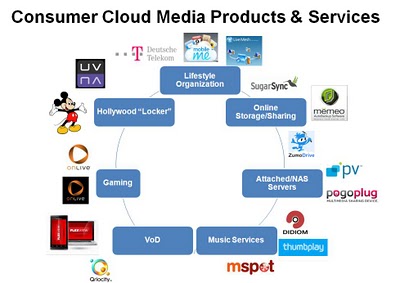In November, we shared some thoughts about what the "cloud" could mean for consumer products and services. For a review, you can click on this link. Microsoft's recent Windows 7 commercials have helped to bring broader market awareness about what practical end-user applications can come as a result of cloud-based services.

E-mail/Calendaring/Family Sync: These are features such as Apple’s mobileme, Microsoft’s Live Mesh, and service provider-offered (Deutsche Telekom is a great example, with a service called Connected Live Experiences at Home) calendaring, messaging, and media (photo) synching across devices such as computers and smartphones. Technology providers in this space include NewBay Software and a past sponsor of CONNECTIONS™ - viacube.
Online Backup Migrating to Cloud Services: The first iteration of online backup was merely as a away to automate back-up of home computers (Carbonite, Mozy, etc.). Services such as SugarSync, SpiderOak, and ZumoDrive are taking online backup and making it a cloud service by making the content accessible (and sharable) from multiple types of IP-connected devices. Motorola just purchased Zecter, the company that developed ZumoDrive. This would indicate that online backup of the smartphone will be more of a focus for handset developers and wireless/mobile carriers.
Consumer Electronics-based Cloud Services: Right now, we see three ways that this is being implemented:
- Attached Storage/NAS Clouds: We’re seeing the major consumer storage companies (Buffalo, Data Robotics, Iomega, Seagate, Western Digital, etc.) implement remote access and interaction with files, media, and content that is stored on attached drives and network-attached storage devices. Again, the interaction can be done with any IP-connected device, including smartphones. At CES, Iomega was heavily promoting this at CES, with something they call the Iomega Personal Cloud).
-
Appliance-based Clouds: If a consumer doesn’t have attached storage or network-attached storage, there are appliances from companies such as Cloud Engines (Pogoplug™), CTERA, and iTwin that turn any device with local storage capabilities into a cloud server. Again, the key is the ability to interact with and access your content from any IP-connected device.
- Smartphone Clouds: Trend Micro showed SafeSync, which is online backup and remote access to your iPhone or Android smartphone content. Carbonite and SugarSync also offer this.
When it comes to digital media, the current iterations of “cloud media” services are what we would term “one-way solutions.” The model today is to host and push content toward the consumer and not necessarily provide for the upload and storage of existing copies of all of your movies and music. Digital music services will probably be the first to move to true two-way clouds, likely starting with Apple, Amazon.com, and perhaps Google.
Music Services: There are few digital music services that are cloud-based today (meaning the consumer can move an iTunes library to a hosted storage service and access it anywhere). The rumor is that Apple will be unveiling something like this.
Video Services: UltraViolet (DECE) and Disney’s KeyChest get the major headlines in this space. They are proposing services where a consumer still buys the physical copy of a movie (Blu-ray), but with that will come a digital copy that is hosted and available on different types of consumer electronics devices. In the meantime, Verizon is already offering Flex View, which allows FiOS subscribers to order a movie (rental or purchase) from multiple types of devices and then access it from different platforms – smartphone, computer, television.
Gaming Services: Again, a very one-way cloud model, where companies such as OnLive have console-style games that can be played on multiple types of connected consumer electronics. At CES, they announced a partnership with VIZIO, where OnLive gaming services will be available on VIZIO’s connected TVs.
Last week, we were quoted in a SmartMoney magazine article about consumer-oriented cloud products and services. The article also made its way to The Wall Street Journal. We certainly see an early market for cloud media in online backup services (Carbonite, Mozy, SugarSync, etc.) extend their functionality to include access to stored content and media on multiple types of IP-connected devices. We also anticipate that appliance-based consumer storage products (attached drives, network-attached storage, etc.) will take on "cloud" attributes, allowing consumers to access and update files and content from any connected device. At the just-completed 2011 CES, news from the Digital Living Content Ecoystem (DECE) - the UltraViolet consumer brand - indicates that we're a step closer to seeing a VoD-based cloud service become consumer-ready.
One quote in the article that I'd like to clarify is one in which I am quoted as saying that "People storing data in the cloud might also save money on their actual gadgets, because they may be able to get by with a smaller hard drive and a less powerful processor."
Actually, what I told the reporter is the opposite of that. We anticipate that - for the foreseeable future - online data/backup services complement local storage such as computers and attached hard drives, because they provide redundancy and the flexibility of multi-platform access. We don’t see this diminishing the need for robust storage in the home over the next five years, but it could eventually bring forth the long-anticipated arrival of “thin client” computing, where devices don’t have to rely on large amounts of storage and processing. But it’s a long-term evolution.

